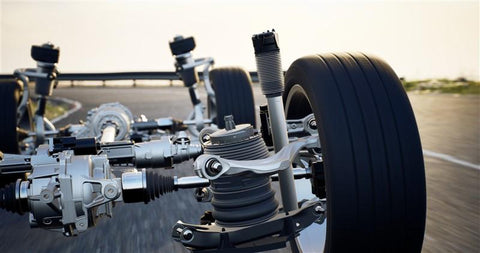Air suspensions are more popular today than ever before. While these active suspension systems used to be reserved for luxury vehicles, these days more automakers are equipping a wider range of their cars with them. But what are the benefits of pneumatic suspensions and what, if any, drawbacks do they have for car owners?
In this article, our Suspension Experts go over the basics of air suspensions and how they work. We also take a look at the pros and cons of an air suspension system, and ultimately, whether or not they’re worth the money to buy, maintain, and repair.
What Is an Air Suspension System?
An air suspension system – also known as a pneumatic suspension or air ride – is a type of active suspension that uses compressed air or other gas to support a vehicle and provide damping capabilities. While they may seem like a relatively new technology, the original patent for an air suspension was filed in 1901 – albeit for a bicycle.
Auto manufacturers first began putting them in consumer vehicles in the late 1950s. However, it wasn’t until the 1980s that they first began appearing regularly on mainstream automobiles. Air suspension systems have soared in popularity over the last couple of decades and are now one of the most popular types of suspensions in the auto industry.
How Do Air Suspension Systems Work?
Modern air suspension systems work by adjusting the pressure in pneumatic springs to respond to changes in the road and driving behaviors. Individual springs provide more or less resistance to actively level out a vehicle’s ride height. This creates a smooth ride for the driver and passengers and can affect a car’s handling.
How Air Suspensions Work: Step-by-Step
The entire air ride cycle happens almost instantly and runs constantly while a vehicle is in motion. Here’s how it works:
- Sensors take ride height readings: Mechanical or electronic ride height sensors mounted at each wheel take a reading of that corner’s height relative to the road surface. These sensors then report this information to a specialized suspension computer.
- Suspension computer processes readings: A small computer known as a suspension control module receives the readings from the ride height sensors. Then, it analyzes them to determine what adjustments need to be made to each spring.
- Control module provides instructions: The suspension control module then instructs an integrated air compressor on how much air it needs to generate to make the necessary adjustments. At the same time, it tells an air manifold which air springs need additional air and how much.
- Air travels through the system: The compressor pushes the air it generates into the reserve tank as air from the tank is delivered to the manifold. The manifold sends air through rubber air lines into the air springs as instructed by the control module.
- Air springs adjust: Finally, the vehicle’s air springs inflate or deflate to make the necessary adjustments based on the initial readings.

Air Suspension System Components
While air ride systems have dozens of parts and vary depending on the system, the main components include:
- Air springs: Also called air bags or pneumatic springs, these assemblies are typically a flexible rubber bladder mounted on top of a strut. They can inflate or deflate to adjust the amount of resistance and give at each wheel.
- Ride height sensors: Either mechanically or electronically, small sensors mounted at each wheel of a car take a constant reading of the ride height at that wheel.
- Suspension control module: A small, specialized computer that acts as the “brain” of a pneumatic suspension system, analyzing ride height readings and instructing other components on what to do.
- Suspension air compressor: This mechanical air compressor is not dissimilar from one you’d find in many garages. However, it is designed specifically for air suspension systems both in terms of fit and function.
- Air suspension manifold: The manifold is what regulates where air goes and how much of it gets sent, based on instructions from the control module.
- Delivery lines: Pneumatic hoses carry air between different components throughout the system.
- Air reserve tank: After the compressor generates pressurized air, it is stored in a reserve tank to be used as needed.
- Seals and gaskets: Although tiny, seals and gaskets are critical to a healthy air suspension system. They prevent air leaks and ensure the overall efficiency of the system.
Air Suspension System Pros & Cons
The increased popularity of air suspension systems means that automakers and consumers both have found value in them. Indeed, there are many upsides to pneumatic suspensions that have made them such a hit. However, they also have some notable downsides that are worth considering.
Air Suspension Advantages
Active air ride systems have several benefits for drivers, including:
- Superior ride quality: When healthy, an air suspension provides a smooth, high-quality ride that is unmatched by almost any other type of system. Their adjustable damping allows drivers to feel as if they are gliding over road surfaces – even if they’re filled with cracks and small potholes.
- More balanced handling: Air ride systems make adjustments for driving behaviors in addition to changes in the road. They can adjust suspension resistance in situations like cornering, allowing them to compensate for changes in weight distribution, resulting in a car that takes turns without feeling like it’s leaning to one side or the other.
- More even wear and tear: Because air suspension systems can actively respond to changes while driving, they are superior to other systems when it comes to evenly distributing stress on a vehicle’s components. That leads to more even wear and tear across components, especially those that are part of a car’s steering and braking systems.
- Adjustability: Many air suspensions allow drivers to adjust the ride height from the cockpit. This has many uses, including raising the height for off-road situations or lowering it when driving at higher speeds.
Air Suspension Disadvantages
While pneumatic suspension systems have many clear benefits, they also have a few notable drawbacks. These include:
- Expense: Air suspension systems have far more components and more expensive components than passive suspensions. This means they’re more expensive to buy in the first place and also more costly to repair and maintain.
- Complexity: Due to the amount of components in the system and the intricate nature of how they function, working on them is more difficult and time-consuming. That complexity also makes it more difficult to diagnose the source of issues. And, in general, more parts means more things that can go wrong.
- Lack of durability: Even as technology has improved by leaps and bounds over the last few decades, air suspensions are still relatively fragile compared to passive systems such as coilovers. The use of moving parts, computers, and flexible materials means they tend to wear out faster and are more susceptible to breaking.
Is Fixing an Air Suspension System Worth It?
If you’ve gotten a repair estimate for fixing your air suspension system, you are well aware of how costly it can be. Given the expense, many drivers may wonder whether it’s worth the expense to repair or replace their air ride components – especially with alternative solutions like air suspension replacement kits on the market.
Cost to Fix an Air Suspension
There’s no way around it. Fixing an air suspension system is expensive. Depending on your vehicle, just one replacement air spring can cost over $1,000 for the part alone. Other components such as the control module and compressor can also be pricey.
Even before you pay for shop labor, you could spend thousands towards repairing an air suspension at the dealership. But getting an air suspension repaired at the dealership is the most expensive way to do it. That’s for two main reasons:
- Expensive labor: Repair shop labor is expensive anywhere, but it tends to come at a premium at dealerships. You can probably find much better rates at your local repair shop.
- Expensive parts: Dealerships will use OEM parts only to fix your air ride. While these parts will match the ones they replace, they also come with high price tags. These days, you can find high-quality alternatives from third-party manufacturers at much lower prices.
Using Aftermarket Air Suspension Parts to Fix an Air Suspension
While dealerships will insist on using (or be required to use) OEM air ride components, you can find aftermarket components that match or even exceed the fit and quality of the original in many cases. Using third-party air suspension parts offers a few advantages for car owners, including:
- Lower price: Aftermarket air suspension parts can cost anywhere from 30-50% less than their OEM components. If you need to replace multiple air springs, for example, using aftermarket parts can easily save you hundreds of dollars or more.
- Improved fit and function: In some cases, being able to observe the OEM parts in action for several years allows aftermarket manufacturers to observe flaws in them. As a result, they can sometimes make replacement parts that address those flaws and offer superior performance.
- Choice of repair shop: Dealing with dealership repair shops can be an expensive hassle. While it can take weeks to get an appointment at the service center, when you buy your own aftermarket air ride parts you can choose where you have them installed. That means you can find a shop you trust with better rates that can fit you in earlier.
Pros and Cons of Fixing an Air Suspension System
If you no longer want to deal with your air suspension, you can choose to replace it entirely. However, for some people, the benefits of an air suspension system far outweigh their disadvantages and the costs of fixing them.
To summarize, here are the main advantages and disadvantages of fixing your air suspension system.
|
Fixing Air Suspension Pros |
Fixing Air Suspension Cons |
|
Can be affordable with high-quality aftermarket replacement parts |
Can be costly and time-consuming, especially when done at a dealership |
|
Keeps ride quality and performance benefits |
May need more repairs in the future |
|
Can extend the lifetime of other components |
OEM parts can be prohibitively expensive |
In addition to the air suspension replacement kits and components Strutmasters is known for, the company also offers high-quality aftermarket air suspension replacement parts. Each of these parts meets Strutmasters’ rigorous standards and comes with a quality guarantee.




